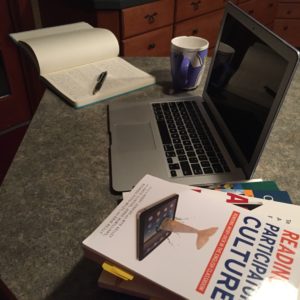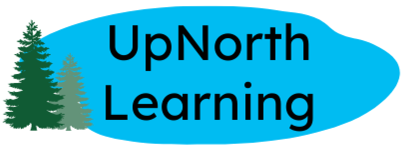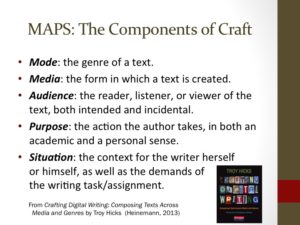
My writing/reading spot.
In the past couple of weeks, I’ve been working on six different writing projects in my professional life — two blog posts, two chapter proposals with a colleague, and two proposals for presentations for the 2017 NCTE Annual Convention with different collaborators. The process of writing for various audiences, purposes, and situations has reminded me not only that I enjoy writing, but that I am a better teacher of writing when I regularly write — whether for personal or professional circumstances. I know I am probably preaching to the converts here, but being a reflective writer makes me a better writing teacher in some very concrete ways.
Recognizing the Struggle. Writing is hard. When I am writing myself, I remember what is challenging about the process, and I recognize the places where I want to quit. I am also reminded of the strategies I use to overcome difficult portions or writer’s block. For instance, I remember that I need time for an idea to germinate. Taking breaks, going for walks, and talking with others are essential parts of my process, but often, they get squelched in my classroom. I remember, too, that sometimes I just have to write through the challenges – trying to get what I can down on paper and knowing that I can improve it later. Most importantly, though, I remember that I don’t have to be alone as a writer — that I can reach out to others for collaboration and feedback during the process not just when I complete the first draft. Transferring what I know about my process into my classroom means committing to an environment that values thought, conversation, and collaboration along the way. It also means sharing my strategies more explicitly with students with my own real rough drafts.
Living the Process. We have all heard it said that writing is a recursive process; writing regularly keeps this at the forefront of my mind. One of the projects I’ve been working on in these last couple of weeks is a collaborative proposal for the 2017 NCTE Convention. My process went something like this
- I drafted some rough ideas and asked colleagues if they might be interested in collaborating with me on submitting a proposal.
- Then I thought about audience which led me to search for help from mentor texts (the convention program, for instance) and advice from successful presenters who might understand the audience better than I.
- I realized that I needed to read (or reread) portions of books or articles to add authority to what I wanted to say.
- I drafted again and then shared the document out with my collaborators.
- Once they added to the document and offered feedback, I drafted more, moved parts, trimmed parts, all the while communicating with my colleagues in our shared document.
- I then sought out editors who I knew would tell us the truth and help us to improve our proposal significantly.
- And, of course, we did final polishing before submitting our proposal.
When I reflect on my process as a writer, I realize how important the read/write/revise cycle is. My process is rarely linear. As a writer, I often stop to read something else — a piece of research, a mentor text, a piece of my own writing from a previous year — in order to move my writing forward. I’m organically driven to these steps, but the growth I experience as a writer in the process is phenomenal. I also realize the power of selecting my own topic and audience. I want to write what I am working on. Can my students say that consistently in my classroom? This reflection gives me additional ideas to help my writers. As a teacher of writing, I know this process needs to be replicated in my classroom, or, at the very least, shared with my students as a strategy they may use. I also remember how important it is that my students write pieces that they care about where a real audience is reading or listening to them.
Writing to the MMAPS. I learned the MMAPS acronym from Troy Hicks as a way to think about mode, media, audience, purpose and situation when writing. I use the acronym with my students, but its meaning deepens for me when I engage in real writing projects of my own. In particular, my teaching of writing could be improved by sharing more about how I weigh and adjust to the demands of purpose, audience, and situation as a writer. For instance, I am new to the situation of writing chapter proposals with a colleague. In fact, in our conversations back and forth, we have both said that we aren’t sure what a chapter proposal should look like. We draw, though, from our experiences in writing academic articles, blog posts, and research-based pieces. Our purpose is to pitch an idea for consideration in a book, but we can only use 100 words to do so. Imagine the intention in searching for just the right structure, word choice, and style. Imagine the struggle! Certainly, as a teacher of writing, I should share this process more with my students. Further, I am reminded that I need to be sure that I am asking them to write in varied modes and media with varying audiences, purposes, and situations, so that they can understand how writers make choices based on these.
Expanding Vocabulary. I have read the research and am a believer about the power of reading to expand vocabularies. Over these past few weeks of intense writing, though, it strikes me that my vocabulary expands significantly in the process of writing. There is something about assembling words on the page — sorting through the words in my head to find the best one, perhaps using a thesaurus to find new words — that expands my vocabulary in the rest of my life. When I am engaged in writing, my vocabulary in speaking, thinking, and questioning in the classroom becomes richer. If this is how my process of building a vocabulary works, might it not work the same for students? We talk frequently in my classes about reading to build a vocabulary, but I look forward to talking with my students about the power of writing to add new words that they might use in all walks of life.
Improving My Mood. I don’t think of myself as an artist when I say I am a writer. Yet, when artists speak of not feeling like themselves if they aren’t expressing themselves in their art, it resonates with me. The truth for me is simple: My mood is better and my thinking clearer when I write regularly. My students need and deserve a teacher who is patient, calm, and content. They need a teacher of writing who can speak enthusiastically about her own writing projects. This is the person I am when I write regularly. When I don’t, I am cranky and resentful of the time spent on tasks other than writing. Writing, like exercise and eating right, takes time, but like those efforts, it energizes me rather than draining me. That’s time well-spent for the sake of my students.
In Write Beside Them, Penny Kittle says, “I believe you have to be a writer, no matter how stumbling and unformed that process is for you; it’s essential to your work as a teacher of writing” (8). So true. I’m glad that these last few weeks have reminded me of the importance of writing regularly for myself and for my students.

